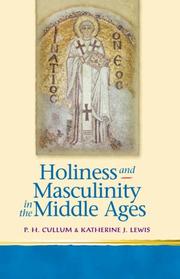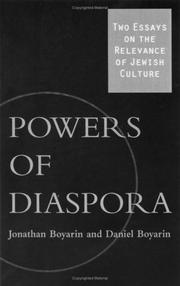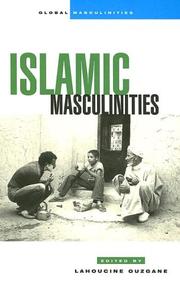| Listing 1 - 10 of 13 | << page >> |
Sort by
|
Book
ISBN: 9781315231488 9781138280762 9781138280779 1315231484 9781351865197 1351865196 9781351865180 1351865188 9781351865203 135186520X 1138280771 1138280763 Year: 2019 Publisher: New York, N.Y. Routledge
Abstract | Keywords | Export | Availability | Bookmark
 Loading...
Loading...Choose an application
- Reference Manager
- EndNote
- RefWorks (Direct export to RefWorks)
Religious studies --- Sociology of health --- Men --- Masculinity --- Psychology --- Religious aspects --- Men - Psychology --- Masculinity - Religious aspects --- Mental health --- Assistance --- Religion --- Book

ISBN: 0708318851 0708318940 9780708318850 9780708318942 Year: 2004 Volume: *3 Publisher: Cardiff University of Wales Press
Abstract | Keywords | Export | Availability | Bookmark
 Loading...
Loading...Choose an application
- Reference Manager
- EndNote
- RefWorks (Direct export to RefWorks)
History of civilization --- Christian church history --- anno 500-1499 --- Masculinity --- History --- Religious aspects --- Christianity --- Civilization, Medieval --- Holiness --- Masculinité --- Sainteté --- Civilisation médiévale --- Congresses. --- Histoire --- Congrès --- Aspect religieux --- Christianisme --- Masculinity - Europe - History - To 1500 --- Masculinity - Religious aspects - Christianity - History - To 1500 --- Saints --- Moyen Age

ISBN: 081663596X 0816635978 9780816635979 9780816635962 Year: 2002 Publisher: Minneapolis (Minn.) : University of Minnesota press,
Abstract | Keywords | Export | Availability | Bookmark
 Loading...
Loading...Choose an application
- Reference Manager
- EndNote
- RefWorks (Direct export to RefWorks)
Jewish diaspora --- Masculinity --- Satmar Hasidim --- Political aspects --- Religious aspects --- Judaism --- Legal status, laws, etc. --- Talmud --- Criticism, interpretation, etc --- Kiryas Joel (N.Y.) --- Ethnic relations --- Political aspects. --- Judaism. --- Legal status, laws, etc --- Jewish diaspora - Political aspects --- Jewish diaspora - Political aspects - Case studies --- Masculinity - Religious aspects - Judaism --- Satmar Hasidim - Legal status, laws, etc. - New York (State) - Kiryas Joel --- Kiryas Joel (N.Y.) - Ethnic relations - Political aspects
Book
ISBN: 9781931112765 1931112762 Year: 2008 Volume: 83 Publisher: Kirksville Truman State university press
Abstract | Keywords | Export | Availability | Bookmark
 Loading...
Loading...Choose an application
- Reference Manager
- EndNote
- RefWorks (Direct export to RefWorks)
Masculinity --- Reformation --- Social change. --- History. --- Religious aspects --- Christianity --- Europe --- History --- Social change --- Change, Social --- Cultural change --- Cultural transformation --- Societal change --- Socio-cultural change --- Social history --- Social evolution --- Masculinity (Psychology) --- Sex (Psychology) --- Men --- Religious aspects&delete& --- Christianity&delete& --- Masculinity - Europe - History. --- Masculinity - Religious aspects - Christianity - History. --- Reformation - Europe. --- Europe - History - 1492-1648.

ISBN: 1842772740 1842772759 9781842772744 9781842772751 Year: 2006 Publisher: London Zed Books
Abstract | Keywords | Export | Availability | Bookmark
 Loading...
Loading...Choose an application
- Reference Manager
- EndNote
- RefWorks (Direct export to RefWorks)
This innovative book outlines the great complexity, variety and difference of male identities in Islamic societies. From the Taliban orphanages of Afghanistan to the cafés of Morocco, from the experience of couples at infertility clinics in Egypt to that of Iraqi conscripts, it shows how the masculine gender is constructed and negotiated in the Islamic Ummah. It goes far beyond the traditional notion that Islamic masculinities are inseparable from the control of women, and shows how the relationship between spirituality and masculinity is experienced quite differently from the prevailing Western norms. Drawing on sources ranging from modern Arabic literature to discussions of Muhammad's virility and Abraham's paternity, it portrays ways of being in the world that intertwine with non-Western conceptions of duty to the family, the state and the divine.
Masculinity --- Men --- Religious aspects --- Islam --- Social conditions --- Developmental psychology --- Social problems --- Sexology --- Sociology of the family. Sociology of sexuality --- Religious studies --- Middle East --- Masculinity - Religious aspects - Islam --- Men - Islamic countries --- Men - Islamic countries - Social conditions --- genderstudies --- genderidentiteit --- islamitische mannen --- Violence --- Homosexuality --- Identity --- Sexuality --- Spirituality --- Book
Book
ISSN: 09249389 ISBN: 1282400959 9786612400957 9047427548 9789047427544 9789004174085 9004174087 Year: 2009 Volume: 36 Publisher: Leiden Boston
Abstract | Keywords | Export | Availability | Bookmark
 Loading...
Loading...Choose an application
- Reference Manager
- EndNote
- RefWorks (Direct export to RefWorks)
Over the last thirty years, issues of gender have been creatively explored within the field of mission studies. Whereas the life and work of female missionaries have been fruitfully reflected upon, male gender identity has often been understood as an unchanging category. This book offers a pioneering account of the relationship between missionary work and masculinity. By examining four individual men this study explores how self-making occurred within foreign missions, but also how conceptions of male gender informed missionary work. Changes that occurred in the lives of these men are placed within the broader context of how issues of gender were renegotiated within the contemporary missionary movement.
Missionar --- Masculinity --- Missionaries --- Religious adherents --- Religious aspects --- Christianity. --- Geschichte 1869-1957 --- China --- Mongolei --- Schweden --- 266:284.1 --- 266 <51> --- Masculinity (Psychology) --- Sex (Psychology) --- Men --- Religious aspects&delete& --- Christianity --- Protestantse missies: gereformeerd --- Missies. Evangelisatie. Zending--China --- Missionaries - China - Biography. --- Missionaries - Mongolia - Biography. --- Missionaries - Sweden - Biography. --- Masculinity - Religious aspects - Christianity.
Book
ISBN: 9780812247527 0812247523 0812291948 Year: 2015 Publisher: Philadelphia, Pennsylvania : University of Pennsylvania Press,
Abstract | Keywords | Export | Availability | Bookmark
 Loading...
Loading...Choose an application
- Reference Manager
- EndNote
- RefWorks (Direct export to RefWorks)
During the High Middle Ages, members of the Anglo-Norman clergy not only routinely took wives but also often prepared their own sons for ecclesiastical careers. As the Anglo-Norman Church began to impose clerical celibacy on the priesthood, reform needed to be carefully negotiated, as it relied on the acceptance of a new definition of masculinity for religious men, one not dependent on conventional male roles in society. The Manly Priest tells the story of the imposition of clerical celibacy in a specific time and place and the resulting social tension and conflict. No longer able to tie manliness to marriage and procreation, priests were instructed to embrace virile chastity, to become manly celibates who continually warred with the desires of the body. Reformers passed legislation to eradicate clerical marriages and prevent clerical sons from inheriting their fathers' benefices. In response, some married clerics authored tracts to uphold their customs of marriage and defend the right of a priest's son to assume clerical office. This resistance eventually waned, as clerical celibacy became the standard for the priesthood. By the thirteenth century, ecclesiastical reformers had further tightened the standard of priestly masculinity by barring other typically masculine behaviors and comportment: gambling, tavern-frequenting, scurrilous speech, and brawling. Charting the progression of the new model of religious masculinity for the priesthood, Jennifer Thibodeaux illustrates this radical alteration and concludes not only that clerical celibacy was a hotly contested movement in high medieval England and Normandy, but that this movement created a new model of manliness for the medieval clergy.
Masculinity --- Celibacy --- Clergy --- Masculinité --- Célibat --- Clergé --- Religious aspects --- Christianity --- History --- Aspect religieux --- Christianisme --- Histoire --- Social conditions --- Masculinité --- Célibat --- Clergé --- Masculinity - Religious aspects - Christianity - History - To 1500. --- Masculinity - France - Normandy - History - To 1500. --- Masculinity - England - History - To 1500. --- Celibacy - Christianity - History - To 1500. --- Celibacy - France - Normandy - History - To 1500. --- Celibacy - England - History - To 1500. --- Clergy - France - Normandy - Social conditions - History - To 1500. --- Clergy - England - Social conditions - History - To 1500. --- Gender Studies. --- History. --- Medieval and Renaissance Studies. --- Religion. --- Religious Studies. --- Women's Studies.
Book
ISBN: 9461661061 9461664281 9058678733 9461664230 9789058678737 Year: 2021 Publisher: Leuven Leuven University Press
Abstract | Keywords | Export | Availability | Bookmark
 Loading...
Loading...Choose an application
- Reference Manager
- EndNote
- RefWorks (Direct export to RefWorks)
"In the mid-nineteenth century, when the idea of religion as a private matter connected to the home and the female sphere won acceptance among the bourgeois elite, Christian religious practices began to be associated with femininity and soft values. Contemporary critics claimed that religion was incompatible with true manhood, and today's scholars talk about a feminisation of religion. But was this really the case? What expression did male religious faith take at a time when Christianity was losing its status as the foundation of society?This is the starting point for the research presented in Christian Masculinity.Here we meet Catholic and Protestant men struggling with and for their Christian faith as priests, missionaries, and laymen, as well as ideas and reflections on Christian masculinity in media, fiction, and correspondence of various kinds. Some men engaged in social and missionary work, or strove to harness the masculine combative spirit to Christian ends, while others were eager to show the male character of Christian virtues. This book not only illustrates the importance of religion for the understanding of gender construction, but also the need to take into consideration confessional and institutional aspects of religious identity. "
Sex role --- Masculinity --- Christian men --- Masculinity (Psychology) --- Sex (Psychology) --- Men --- Religious aspects. --- History. --- Religious aspects --- Christianity. --- Conduct of life. --- Europe, Northern --- Northern Europe --- Church history. --- City planning --- Church buildings --- Christianity --- Religions --- Church history --- Churches --- Buildings --- Church facilities --- Church architecture --- Christian men - Europe, Northern --- Christian men - Conduct of life --- Masculinity - Religious aspects - Christianity --- Masculinity - Europe, Northern - History --- Sex role - Religious aspects --- Europe, Northern - Church history --- christian masculinity; religion; gender construction; religious identity --- Europe
Book
ISBN: 9780230222205 023022220X 1349307742 9786612997600 0230290469 1282997602 9781349307746 Year: 2010 Publisher: Basingstoke Palgrave Macmillan
Abstract | Keywords | Export | Availability | Bookmark
 Loading...
Loading...Choose an application
- Reference Manager
- EndNote
- RefWorks (Direct export to RefWorks)
"Was a medieval priest viewed as masculine by his parishioners? Did a monk consider himself fully male? How did a bishop assert his masculinity in conflicts with secular authorities? These are some of the questions posed by Negotiating clerical identities. In this volume, Jennifer Thibodeaux has assembled the most cutting-edge research today on medieval clerics and masculine performances. Spanning a wide range of geographical contexts and time periods, the essays in this volume illuminate the ways in which medieval clerics performed masculinity and negotiated their gender identities, both with lay society and within the various orders of the medieval church."--Cover, p. [4].
History of civilization --- Christian church history --- anno 500-1499 --- Europe: North-West --- 305 --- 27 "04/14" --- 262.1 --- 271 "04/14" --- Genderstudies. Rol van de sekse. Gender. Personen vanuit interdisciplinair gezichtspunt --- Kerkgeschiedenis--Middeleeuwen --- Bedienaars van de eredienst. Kerkelijke hiërarchie. Kerkelijke ambten --- Kloosterwezen. Religieuze orden en congregaties. Monachisme--Middeleeuwen --- Clergy --- Masculinity --- Klerus. --- Männlichkeit. --- Sexuelle Identität. --- Social conditions. --- History --- Religious aspects --- Geschichte 700-1500. --- 262.1 Bedienaars van de eredienst. Kerkelijke hiërarchie. Kerkelijke ambten --- 305 Genderstudies. Rol van de sekse. Gender. Personen vanuit interdisciplinair gezichtspunt --- Clergy - Social conditions --- Clergy - History - To 1500 --- Masculinity - Religious aspects - History - To 1500

ISBN: 0674006348 0674011252 9780674006348 Year: 2003 Publisher: Cambridge, Mass. Harvard University Press
Abstract | Keywords | Export | Availability | Bookmark
 Loading...
Loading...Choose an application
- Reference Manager
- EndNote
- RefWorks (Direct export to RefWorks)
Protestant churches --- Masculinity --- Sports --- History. --- Religious aspects --- Christianity --- -Masculinity --- -Protestant churches --- -Sports --- -Field sports --- Pastimes --- Recreations --- Recreation --- Athletics --- Games --- Outdoor life --- Physical education and training --- Protestant sects --- Christian sects --- Protestantism --- Masculinity (Psychology) --- Sex (Psychology) --- Men --- -Christianity --- -History --- History --- United States --- Church history. --- -Religious aspects --- History of North America --- History of civilization --- Christian church history --- anno 1800-1999 --- Field sports --- Religious aspects&delete& --- Protestant churches&delete& --- Social life and customs --- Protestant churches - United States - History. --- Masculinity - Religious aspects - Christianity - History. --- Sports - Religious aspects - Christianity - History. --- Masculinity - United States - History. --- Sports - United States - History. --- United States of America
| Listing 1 - 10 of 13 | << page >> |
Sort by
|

 Search
Search Feedback
Feedback About UniCat
About UniCat  Help
Help News
News